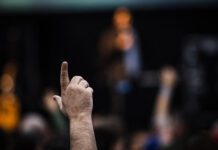The Verge Network asked five notable leaders the same question: How do you train leaders? Although their answers are varied, you may be able to identify some common themes. Their answers:
Matt Carter serves as the pastor of preaching and vision at the Austin Stone Community Church:
We’ve changed how we’re training and discipling our leaders. We’re teaching them to be self-feeders versus consumers only. We’re teaching them how to be self-feeders versus consumers because today in most churches, if you’re a typical American Christian, it’s pretty cool and it’s totally okay for you to just come to a Bible study and just sit there and learn by consuming.
You can go on for years like that, but if you’re going to be, say, a missionary in the Sudan, you better have made a transition in your life from just being a person sitting there and consuming someone else’s teaching. You better be able to get into the Word of God and let the Word of God speak to you through the Holy Spirit and make that transition into your life from a person who is just hearing somebody else preach to a person who is a self-feeder and putting that stuff into action. So long story short, what we’re doing is we’re training our people like missionaries.
Hugh Halter is the national director of Missio:
The first line of training is to actually model the behavior. We identify some existing leaders in the church who tend to be on the more incarnational end. They’re probably really good with people outside the church; they have some gifting in hospitality, they have the ability to have a whole host of different types of people in their home, and they can model and integrate an environment.
The second thing we do is we get all of our leaders together, and we constantly talk about what it means to actually lead a missional community. So just like you’re training a small community to go overseas on mission, we actually take the same approach here locally, within our existing church.
We try to give our best training and time to our leaders. Sometimes, we’re teaching them pastoral gifting. Sometimes, we’re teaching them issues about how to engage culture. A lot of times, we’re processing through the formation of community. What’s that look like? What’s that feel like? I think the modeling and drawing people into the experience is always the best way of leadership as opposed to a cognitive training and then send them off, “God bless you,” type of idea.
Rob Wegner serves as a teaching pastor at Granger Community Church:
The way we’ve come at this was first through missional communities in India. We’ve been a part of an indigenous church-planting movement there for about 10 years, and it’s not the typical approach.
We’ve been involved in training indigenous leaders, and most of the churches are what many people would call missional communities. They’re groups of 20, 30, 40, or 50 people, each reaching unique pockets of people or unique people groups. But what’s unique about it is they’re actually small and reproducing.
We’ve developed a 15-month coaching process. The first level of training is called the Kingdom of God training. It walks them through five modules of training. They gather in batches of about 30 – similar to an intensive training for 2 to 3 days – and it takes them through the startup of a missional community.
Then we do what we call relational mapping. We have them sit down and say, “Okay, let’s write down everything you do in a month. Alright, now I want you to assign a name to that.” So suddenly, they have a map of the people they are actually doing life with. We help them see that, “This is your church. Now these are the people that you need to start discipling.”
Then they focus on disciple making. This is a layered approach that is a practitioner-based model, where each one of these batches is led by a trainer and a coach who has successfully led a missional community. Then they stay in touch with the folks in their coaching batch every week. So there are intensives, then there is weekly coaching, and you don’t move on unless you are actually implementing the first one.
It’s not like, “Did I get the information, and can I pass the test?” It’s like, “No, you’re actually living it. And if you’re not, you don’t go on.”
The training is tri-perspectival, focusing on the head, the heart, and the hands. So it is a combination training in theology, practical skills, and character formation. With each batch, we’re raising up new coaches and new trainers. So from day one you’re telling everyone, “Hey, you’re going to be the coach. In fact, you’re coaching somebody right now. So go!”
So the expectation is reproduction. Reproducing is maturity. This is the model we’re trying to implement with our leaders.
Lance Ford is a national team leader with Forge America:
In training leaders of missional communities, our approach is to go easy on the leader-speak while concentrating on the follower-posture, of being a good news or, gospel person. We want to help potential leaders carve their doing out of their being. This eliminates undue pressure and distraction on periphery issues and brings a concentration on the walking with Jesus centrality that is so vital to missional living.
A leader must first live missionally before he or she can lead missionally in an authentic way. We want to develop followable leaders who will develop a lineage of followable leaders. Specifically, we want to help missional community leaders develop a seamless rhythm of mission in his or her own life.
Beginning with spiritual formation as a basis, we help them develop a hearing ear and space in their daily life to actually hear from God and to expect to hear from God. This is essential. If a person is not taking her cues from the Holy Spirit as she goes through her day, then she will not be able to respond in natural ways.
Redefining fellowship and brotherhood is at the basis of common community, the second necessary sphere of missional community leader training. Otherly living is not easy for any of us. It doesn’t come naturally, especially for individualistic Westerners. The beauty of biblical hospitality, sharing, and genuine familial concern and action is essential for genuine missional communities to come into being.
For us, missional living is a third sphere of discipleship that authenticates our lives as followers of Jesus. We must train missional community leaders to live with the eyes of a missionary.
The sent (“missio”) nature of a disciple involves moving throughout our day looking and listening for redemptive opportunities. A variety of situations, some seeming to be big, others appearing to be small, present themselves as opportunities to exercise our missional muscles as the sent people of God. The key is to live with eyes and ears open to what the Holy Spirit says as you go through your day. This is where the spiritual formation component is so vital as the foundation for our daily lives.
An integrated rhythm of missional posture is not a linear set of steps. It is more like a dance. A dance of life with God as our leading partner.
Reggie McNeal is the missional leadership specialist for Leadership Network:
The single biggest theme in training is apprenticing so that people do it, and then they learn from it. In some cases, they’re actually assigned coaches who are very serious and almost formalized in their debriefing processes. Every missional community system that I’m in touch with is always scouring, looking for the next wave of leaders. They emerge from inside the missional community. Then they’re apprenticed by the existing leader.
I also find that almost all of these systems have some kind of very pointed leadership gatherings, whether it’s once a quarter or once a month or three times a year. There will be some kind of convening of the leaders to celebrate the work, do peer-to-peer sharing and mentoring, and then again some intentional coaching.
Depending on the network, there will be some front-end kind of curricular type of introduction so the key issues leaders are going to face will be addressed before they’re deployed. Maybe that’s done alongside this apprenticing model so that it’s introduced, and then their newer leader is given material to read to process with the existing community leader.
Finally, a major theme of all the training is the personal, spiritual formation of a leader. One of the real limits of the typical program church model would be that we tend to train for tasks, so we teach elders to eld, teachers to teach, deacons to deac, and ushers to ush, that kind of thing, but there’s not necessarily an attention to the leader who is doing the leadership.
A very huge differential for me in the missional community piece is to start with the leader (that’s always key) and the spiritual formation of the leader, because this leadership in missional community is lived out in community and on the ground and in full view. It’s not a positional leadership; it’s a personal leadership. Any leadership training that doesn’t address that, of course, is just not conceivable in the missional community world.













